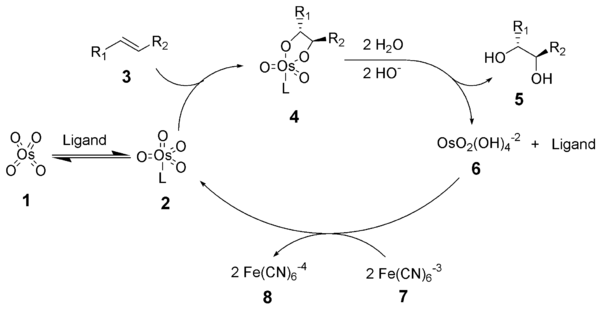- Sharpless asymmetric dihydroxylation
-
Sharpless asymmetric dihydroxylation (also called the Sharpless bishydroxylation) is the chemical reaction of an alkene with osmium tetroxide in the presence of a chiral quinine ligand to form a vicinal diol.[1][2][3]
It is common practice to perform this reaction using a catalytic amount of osmium tetroxide, which after reaction is regenerated with either potassium ferricyanide[4][5] or N-methylmorpholine N-oxide.[6][7] This dramatically reduces the amount of the highly toxic and very expensive osmium tetroxide needed. These four reagents are commercially available premixed ("AD-mix") The mixture containing (DHQ)2-PHAL is called AD-mix-α, and the mixture containing (DHQD)2-PHAL is called AD-mix-β.[8]
Such chiral diols are important in organic synthesis. The introduction of chirality into nonchiral reactants through usage of a chiral catalysts is an important concept in organic synthesis. This reaction was developed principally by K. Barry Sharpless building on the already known racemic Upjohn dihydroxylation, for which he was awarded a share of the 2001 Nobel Prize in Chemistry.
Contents
Reaction mechanism
The reaction mechanism of the Sharpless dihydroxylation begins with the formation of the osmium tetroxide - ligand complex (2). A [3+2]-cycloaddition with the alkene (3) gives the cyclic intermediate 4.[9][10] Basic hydrolysis liberates the diol (5) and the reduced osmate (6). Finally, the stoichiometric oxidant regenerates the osmium tetroxide - ligand complex (2).
Application
Dihydroxylation in the absence of a coordinating ligand requires the use of a stoichiometric amount of osmium.[11][12][13] Catalytic, asymmetric dihydroxylation reduces the cost of this procedure one thousandfold, opening the door for advances in biomimetic and sympathetic osmates.
Asymmetric dihydroxylation has been applied to alkenes of every substitution, and high enantioselectivities have been realized for every substitution pattern. Asymmetric dihydroxylation reactions are also highly site selective, providing products derived from reaction of the most electron-rich double bond in the substrate.[14]
Examples

The first step in the synthesis of azasugar 6 is a dihydroxylation reaction[15] of the prochiral diene 1. Azasugars are pharmacologically relevant. The entire reaction sequence takes place in water as a reaction medium and protective groups were not required. Notice the chemoselectivity in the nucleophilic substitution of bromine by the hydroxyl group in step 2.
For another example of this reaction see: Kuwajima Taxol total synthesis
References
- ^ Jacobsen, E. N.; Marko, I.; Mungall, W. S.; Schroeder, G.; Sharpless, K. B. J. Am. Chem. Soc. 1988, 110, 1968. (doi:10.1021/ja00214a053)
- ^ Kolb, H. C.; Van Nieuwenhze, M. S.; Sharpless, K. B. Chem. Rev. 1994, 94, 2483-2547. (Review) (doi:10.1021/cr00032a009)
- ^ Gonzalez, J.; Aurigemma, C.; Truesdale, L. Org. Syn., Coll. Vol. 10, p.603 (2004); Vol. 79, p.93 (2002). (Article)
- ^ Minato, M.; Yamamoto, K.; Tsuji, J. J. Org. Chem. 1990, 55, 766-768. (doi:10.1021/jo00289a066)
- ^ Oi, R.; Sharpless, K. B. Org. Syn., Coll. Vol. 9, p.251 (1998); Vol. 73, p.1 (1996). (Article)
- ^ VanRheenen, V.; Kelly, R. C.; Cha, D. Y. Tetrahedron Lett. 1976, 1973-1976.
- ^ McKee, B. H.; Gilheany, D. G.; Sharpless, K. B. Org. Syn., Coll. Vol. 9, p.383 (1998); Vol. 70, p.47 (1992). (Article)
- ^ Sharpless, K. B., et al. J. Org. Chem. 1992, 57, 2768-2771. (doi:10.1021/jo00036a003)
- ^ Corey, E.J.; Noe, M. C.; Grogan, M. J. Tetrahedron Lett. 1996, 37, 4899-4902.
- ^ DelMonte, A. J.; Haller, J.; Houk, K. N.; Sharpless, K. B.; Singleton, D. A.; Strassner, T.; Thomas, A. A. J. Am. Chem. Soc. 1997, 119, 9907-9908. (doi:10.1021/ja971650e)
- ^ Jacobsen, E. N.; Marko, I.; Mungall, W. S.; Schroeder, G.; Sharpless, K. B. J. Am. Chem. Soc. 1988, 110, 1968. (doi:10.1021/ja00214a053)
- ^ Kolb, H. C.; Van Nieuwenhze, M. S.; Sharpless, K. B. Chem. Rev. 1994, 94, 2483-2547. (Review) (doi:10.1021/cr00032a009)
- ^ Gonzalez, J.; Aurigemma, C.; Truesdale, L. Org. Syn., Coll. Vol. 10, p.603 (2004); Vol. 79, p.93 (2002). (Article)
- ^ Noe, M. C.; Letavic, M. A.; Snow, S. L. Org. React. 2005, 66, 109. (doi:10.1002/0471264180.or066.02)
- ^ Efficient asymmetric synthesis of an azasugar in water Ulf M. Lindström, Rui Ding, Olle Hidestål Chemical Communications 2005, 1773.
See also
- Asymmetric catalytic oxidation
- Milas hydroxylation
- Upjohn dihydroxylation
- Sharpless aminohydroxylation
Categories:- Organic redox reactions
- Name reactions
Wikimedia Foundation. 2010.


